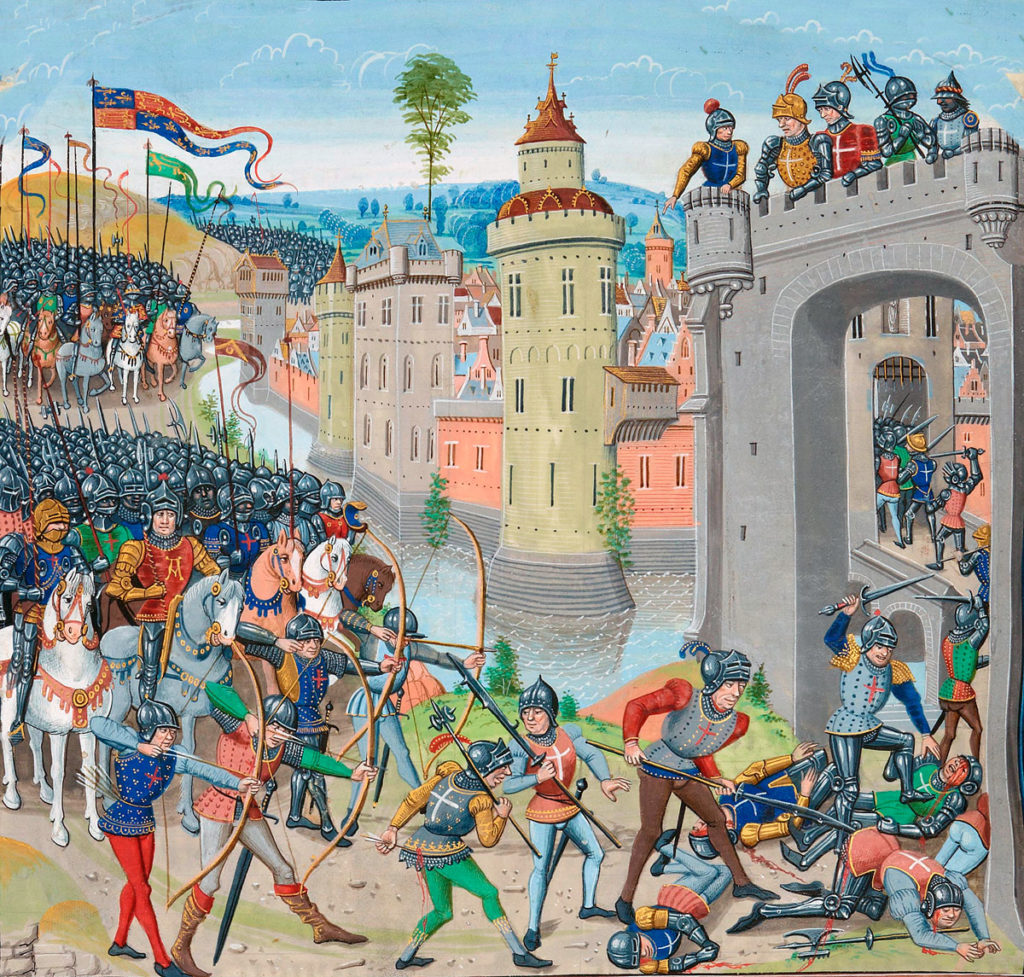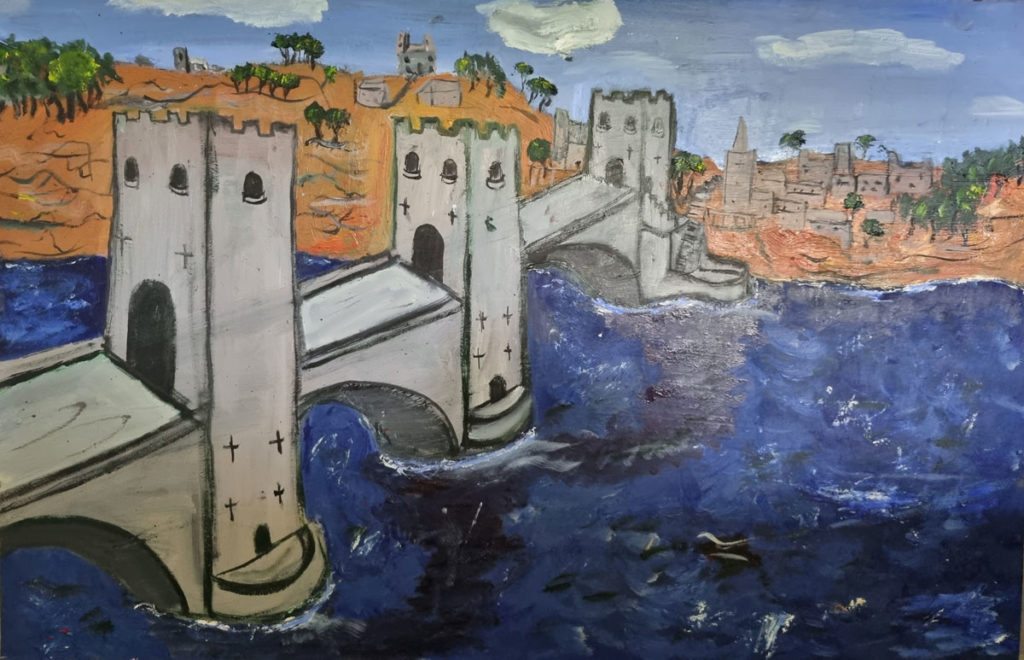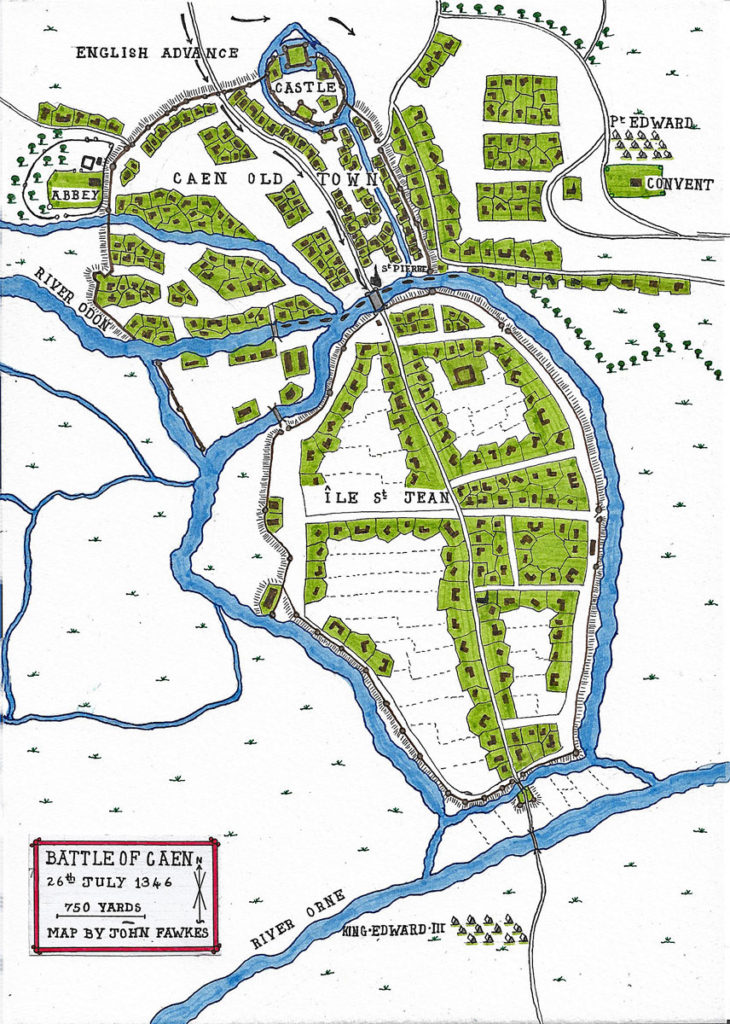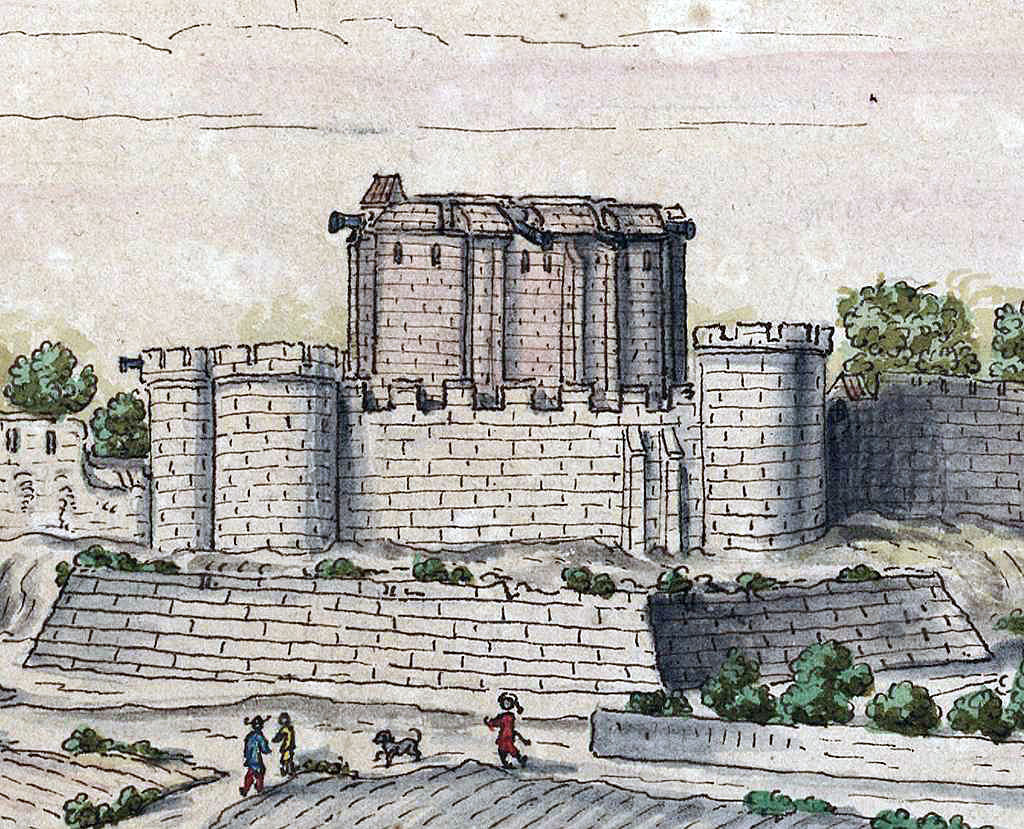The English capture of the French town of Caen on 26th July 1346 in the Hundred Years War at the beginning of King Edward III’s invasion of France
The previous battle of the Hundred Years War is the Battle of Auberoche
The next battle in the Hundred Years War is the Battle of Creçy
War: Hundred Years War.
Date of the Battle of Caen: 26th July 1346
Place of the Battle of Caen: the town of Caen in northern Normandy near the English Channel coast.
Combatants at the Battle of Caen: An English army attacked the French garrison.
Commanders at the Battle of Caen: King Edward III commanded the English army, although the main attack was by the Earl of Warwick.
The French garrison was commanded by the Constable of France, the Comte d’Eu and the Chancellor of Normandy, the Lord of Tancarville.
Size of the armies at the Battle of Caen: The English army numbered around 10,000 to 12,000 men.
The French garrison numbered around 1,500 men, including 400 Genoese crossbowmen. The inhabitants of the town joined in the defence with such weapons as they could find.
Uniforms, arms and equipment at the Battle of Caen: Knights increasingly wore steel plate armour with visored helmets. Their weapons were lance, shield, sword, various forms of mace or club and dagger. Many carried two-handed swords in battle. Each knight was identified by his coat of arms worn on his surcoat, shield and lance pennon.
The archers main weapon was a powerful longbow, capable of many aimed shots a minute.
For hand-to-hand combat archers carried swords, daggers, hatchets and war hammers. They wore jackets and loose hose. Archers’ headgear was a skull cap either of boiled leather or wickerwork ribbed with a steel frame.
The crossbow carried by the French Genoese mercenaries fired a bolt over a shorter range than the longbow and the rate of fire was much slower, as the bow-string had to be cranked back for each shot.
Winner of the Battle of Caen: the English stormed the town of Caen in a day, killing or capturing the garrison of the town, but were unable to take the castle over the next five days.
Events leading to the Battle of Caen:
King Edward III sailed from Portsmouth on 28th June 1346 to begin his invasion of France, landing on the beach of Saint-Vaast-la-Hogue on the eastern side of the Cherbourg peninsula in Normandy in north-west France.
The towns of Hogue and Barfleur were looted and burned by the English soldiers and seamen, contrary to strict orders issued by King Edward.
The English army marched out on 18th July 1346, making for the Normandy capital of Rouen, looting and burning the undefended town of Valognes.
The French suffered from an almost complete lack of troops in western Normandy.
The English army passed through the undefended town of Carentan, pillaging and burning it, before moving on to St Lô.
Initially, the French commander in western Normandy, Robert Bertrand intended to defend St Lô against the English, but once Edward’s army was across the River Vire, Bertrand abandoned St Lô, leaving it to be pillaged and burnt.
The French Constable, Raoul II, Comte d’Eu, resolved to halt Edward’s eastward advance at the town of Caen on the River Orne, the largest walled town west of Rouen.
The English army reached within 10 miles of Caen on 25th July 1346.
Edward sent a messenger to the council of Caen inviting it to surrender the town and guaranteeing the town’s integrity if it did.
The Bishop of Bayeux, presiding over the council, tore up Edward’s letter and threw his messenger into prison.
The walled town of Caen lay on the bank of the River Odon, its castle, built by William the Conqueror, situated on the northern side.
A fortified bridge led across the River Odon to the southern suburb situated on the Ile St Jean.
The River Orne lay along the southern bank of the Ile St Jean, with branches on either side of the island flowing north into the River Orne.
To the west of the main town lay the fortified abbey established by William the Conqueror and to the east a convent.
The French garrison was insufficient to defend the abbey and convent.
A line of thirty boats manned by crossbowmen was moored along the bank of the Odon to strengthen the defences along the river.
Account of the Battle of Caen:
The English army arrived outside Caen on 26th July 1346.
Edward III intended a methodical attack on the town, but his hand was unexpectedly forced.
The King pitched camp at the southern end of Caen while the Prince of Wales, the Black Prince, led his division to the convent on the eastern side, intending to camp there.
In the meantime a party of English men-at-arms and archers led by the Earl of Warwick and followed by the Earl of Northampton and Sir Richard Talbot with their men unexepectedly and without orders stormed the gate to the west of the castle.
Warwick’s party forced its way through the town to the fortified bridge over the River Odon, where savage fighting took place with the French garrison.
Hearing of the attack and considering it to be premature, King Edward III sent word to Warwick ordering him to withdraw, but Warwick’s signal was ignored by his men who continued their frenzied assault.
The fighting spread along the river bank, with the English men-at-arms and archers setting fire to some of the boats, using others to cross the river into the Ile St Jean suburb.
The focal point of the savage fighting was the fortified bridge across the River Odon.
The French garrison in the fortified bridge was taken in the rear by English troops who had crossed the river.
The French commanders retreated into the upper chambers of the towers on the fortified bridge, while their men fought to keep the English at bay, until they were annihilated, other than the few knights and senior commanders who managed to surrender.
Robert Bertrand escaped into the town and made his way to the castle.
Storming across the River Odin, the English troops looted and burned the Ile St Jean suburb, killing most of those inhabitants who did not manage to escape into the countryside.
The garrison of the castle did little to assist their fellow countrymen in their defence of the main part of the town.
Casualties at the Battle of Caen:
Casualties among the French garrison and residents of Caen are reported at 5,000 dead.
Around 100 knights and 120 squires were taken prisoner by the English and held to ransom, along with the wealthier citizens of the town.
The Constable, the Comte d’Eu, recognised Sir Thomas Holland from a previous campaign in which they had been comrades and surrendered to him.
The Chamberlain of Normandy, the Lord of Tancarville, surrendered to Sir Thomas Daniel, one of the Prince of Wales’ retainers.
Follow-up to the Battle of Caen:
The English army spent five days in Caen attempting unsuccessfully to capture the castle, before marching on east towards Paris, to the battlefield of Creçy and the siege of Calais.
Anecdotes and traditions from the Battle of Caen:
- In the records of the municipality of Caen King Edward’s clerks found a copy of the agreement made in March 1338 between King Philip VI of France and the communities of Normandy setting out French plans to invade and despoil England. This document was sent to England and circulated widely, increasing the popularity of Edward’s invasion of France.
- Raoul de Brienne, the Comte d’Eu and Constable of France, returned to Paris four years after his capture, finally having satisfied King Edward III’s ransom demand of 80,000 gold écus by delivering to the English king the county and castle of Guines, lying to the south of Calais and of considerable significance in the contest over the town. The new French King John II considered this an act of treason on the part of the Constable and on 16th November 1350 the Comte d’Eu was executed.
References for the Battle of Caen:
Trial by Fire, Volume II of The Hundred Years War by Jonathan Sumption
The Hundred Years War by Robin Neillands.
The previous battle of the Hundred Years War is the Battle of Auberoche
The next battle in the Hundred Years War is the Battle of Creçy



